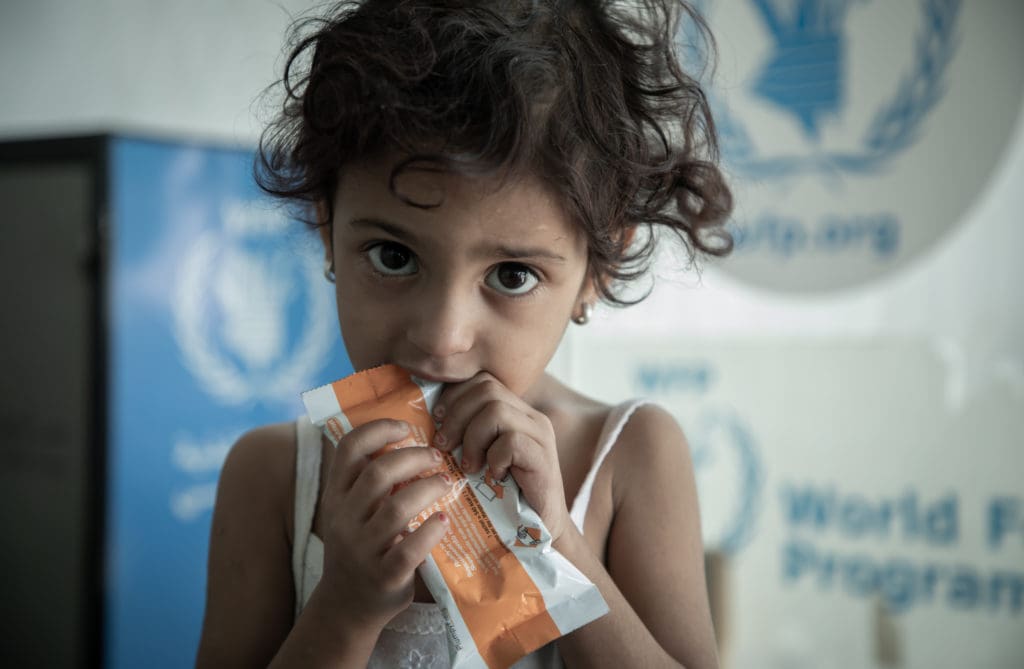The Coolest Job You’ve Never Heard of: Keeping 4M Tons of Food From Going Bad

Packaging engineer? It’s hardly the first professional profile that springs to mind when you think of humanitarian work. And yet, for an organization like the United Nations World Food Programme (WFP) — which handles, moves and distributes millions of tons of food every year — knowing how to optimize packaging can be, quite literally, a lifesaver.

Carole Manceau, the U.N. World Food Programme’s packaging expert, visits a warehouse in Pakistan. U.N. World Food Programme logistics officers and food technologists in the field help her identify issues.
Let’s start with this troubling figure: Nearly one-third of all food produced globally each year is lost or wasted. What’s more disturbing? That’s enough food to feed nearly twice the number of people that go to bed hungry every night.
It’s important to make a distinction between food loss — which refers to food becoming unfit for human consumption — and waste — which happens when food that could be eaten is thrown away. The U.N. World Food Programme’s packaging expert Carole Manceau explains:
“When food is lost or wasted, all of the natural resources and energy that went into producing, processing, transporting and distributing it are also wasted. Packaging accounts for about 10 percent of this energy, but it can play a crucial role in ensuring the other 90 percent is not wasted.”

Packaging helps the U.N. World Food Programme deliver safe, nutritious food in places such as South Sudan.
Food safety is an inherent part of understanding food loss. If dried grains become moldy or cooking oil spoils because of faulty packaging, then it not only adds to food loss, it could make people sick.
“Of course packaging alone cannot fix the issue,” Manceau continues. “But for us at the U.N. World Food Programme it can make a very big difference in terms of how much food reaches people in need rather than being wasted and lost along the supply chain.”
How does it do that, though?
“Adequate packaging can protect our food from suffering mechanical damage while it’s being loaded, offloaded, transported on bumpy roads or dropped from a plane,” says Manceau. “It can also preserve its quality in difficult environmental conditions — extreme temperatures, humidity, dust — that could affect its shelf life. Packaging can also help to prevent food fraud and to defend food from intentional tampering and contamination, in particular through efficient traceability system.”
Manceau is not alone in her quest for better performing packaging: Supply chain officers and food technologists across U.N. World Food Programme’s global operations are her allies. They help understand the challenges of a very complex supply chain and provide feedback on issues.

During emergencies, like after the cyclones in Mozambique, the U.N. World Food Programme food saves lives.
“Recently, we looked at the containers we use to transport vegetable oil. We had reoccurring reports of leakages, which result in losses and threaten to damage the quality of the product,” she says.
“We have been working with our suppliers to understand the causes of this, trying to find out whether the design was affecting the resistance of the containers, or if there was an issue with the density of the material used. This resulted in the definition of a more stringent packaging specification, which includes minimum requirements for the containers to cope with the specificities of our supply chain.”
Finding the ‘Ideal’ Solution Is a Difficult Balancing Act
The need for sturdy packaging that can withstand rough rides, lots of handling and being stacked in piles must be combined with considerations related to cost, functionalities (e.g. ease of use, preservation) and — increasingly — environmental sustainability.

U.N. World Food Programme packaging is widely repurposed and reused. Here, bags serve as planting containers in Kakuma refugee camp in Kenya.
“Also, we need to ensure that whatever solution we adopt can be procured by our suppliers, wherever they might be,” Manceau explains.
There is enough to keep a curious, inquisitive mind like Manceau’s busy, especially in an organization whose reason for being is feeding people, where the needs of those who receive the food are all-important.
“Understanding what works best for the people who receive our assistance is one of our main concerns. Are the bags too heavy? Are smaller packaging formats more convenient? Is our packaging being reused, and how? These are the questions we constantly ask to improve the experience of those we serve,” Manceau says.
Food safety is always top-of-mind. “For example, the lipid-based nutrient supplement we distribute to combat malnutrition in children used to come in pots that contained a week’s rations. However, we found that this led to losses, as it was not always possible to preserve the integrity of the product once opened. So we switched to daily rations in sachets. These contain exactly the right amount the child needs to eat, and are easier to use for the mothers,” she explains.
Incidentally, this choice helped cut down on transport costs, as you can fit 12 percent more rations in the same space, compared to the larger pots.

From Yemen to Niger, individual portion sachets like the one pictured here are helping increase food safety and limit the waste of lipid-based supplements used to combat malnutrition in children.
In sum, the challenge of navigating the trade-offs between multiple needs, actors and constraints is a mighty one, but the goal — more food to people in need, increased quality, safety and nutritional value, and lower environmental impact — makes it worth it, and Manceau embraces it with enthusiasm.
“Things move fast in the packaging world — new materials and technologies, — and it is a privilege to put this innovation at the service of humanity,” she concludes.
This story was written by Simona Beltrami and originally appeared on WFP’s Insights on October 15, 2019.




